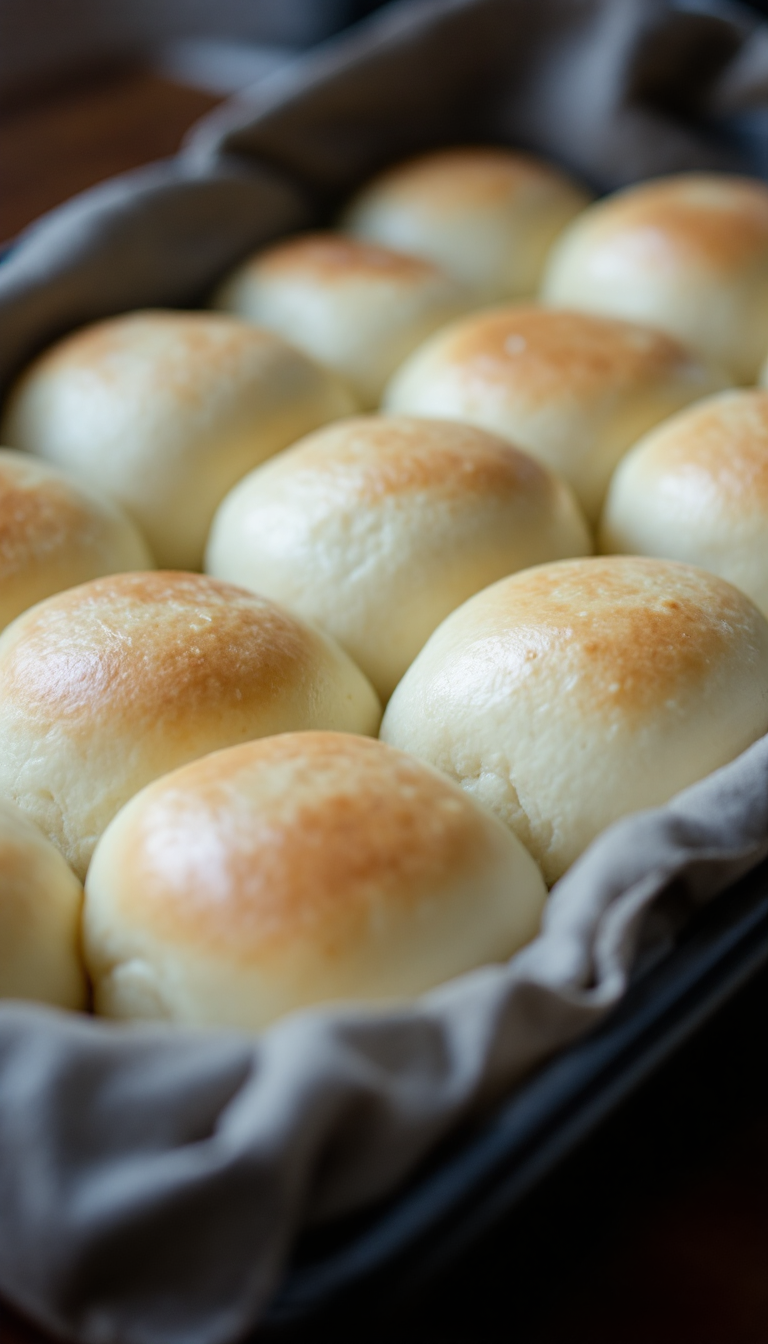Ah, the humble dinner roll—a staple at every holiday feast, family gathering, or Sunday dinner that somehow, with its soft and airy texture, manages to steal the spotlight. I remember the first time I attempted to make them; I was nervous, like a contestant on a baking show, hoping the yeast would rise to the occasion.
Spoiler alert: it did!
There’s something almost magical about the way these rolls transform from simple dough to golden perfection, their aroma wafting through the kitchen like a warm hug. And speaking of hugs, these rolls have been the comforting embrace we needed during those early-pandemic bread-baking marathons when everyone was turning their kitchens into makeshift bakeries.
Now, as we navigate our way back to bustling holiday tables, these make-ahead rolls ensure you can focus more on the laughter and less on last-minute kitchen chaos. So, grab your apron, and let’s get rolling—pun absolutely intended!
Steps
- Heat milk and water to 115F (46C) and pour into a large bowl. Mix in the yeast and a teaspoon of sugar, letting it sit until foamy for about 5-10 minutes.
- Add the remaining sugar, melted butter, eggs, salt, and 2 cups of bread flour to the yeast mixture. Stir until everything is well combined.
- Gradually add more flour, mixing until the dough forms a ball and pulls away from the bowl’s sides.
- Transfer the dough to a lightly floured surface and knead until smooth and elastic, adding more flour if sticky. This process should take about 10 minutes by hand or 5 minutes with a stand mixer.
- Lightly grease a large bowl with oil, place the dough inside, turn it to coat with oil, and cover with plastic wrap. Let it rise in a warm spot until it doubles in size, about 1-2 hours.
- If baking the same day, preheat the oven to 375F (190C). Grease a 9×13” dish with butter, punch down the dough, and divide it into 24 equal portions.
- Shape each portion into a ball, pulling down the sides to create tension, and place in the baking dish so they barely touch.
- For same-day baking, cover the dish with plastic wrap and let the dough rise in a warm place until increased by 50%. Bake for 22-24 minutes until golden brown.
- For next-day baking, cover the dish with plastic wrap and refrigerate overnight. The next day, bring to room temperature while preheating the oven to 375F (190C).
- Remove the plastic wrap and bake for 25-30 minutes until the rolls are golden brown on top.
- After baking, brush the tops with melted butter if desired and serve warm.
Ingredients
- ahead dinner rolls:
- ¾ cup whole milk
- ? cup water
- 2 ½ teaspoons active dry yeast
- ¼ cup (50 g) granulated sugar, plus 1 teaspoon
- ? cup (75 g) unsalted butter, melted
- 2 large eggs, preferably at room temperature
- 1 ½ teaspoons salt
- 4 – 5 cups (500-625 g) bread flour, with extra as needed
- 2 tablespoons butter, softened, for greasing the baking dish
- 3 tablespoons melted salted butter, for brushing the rolls after baking (optional)
Nutritional Values
Calories: 3312kcal | Carbohydrates: 432g | Protein: 72g | Fat: 144g | Saturated Fat: 72g | Polyunsaturated Fat: 10g | Monounsaturated Fat: 48g | Trans Fat: 5g | Cholesterol: 672mg | Sodium: 4152mg | Potassium: 1008mg | Fiber: 24g | Sugar: 72g | Vitamin A: 4416IU | Vitamin C: N/A | Calcium: 384mg | Iron: 7.2mg
FAQ
- Can I freeze the dinner rolls?
- Yes, you can freeze the rolls after baking. Allow them to cool, then wrap tightly and place in an airtight container to store in the freezer for several months. Freezing before baking is possible, though not tested with this recipe. Look into resources for pre-baking freezing methods if interested.
- Is it possible to double this recipe?
- Absolutely. Simply double all ingredients, including the yeast. Make sure you have two 9×13″ pans available. Note that rolls baked in a glass pan may take longer than those in a metal pan.
- Can I use instant yeast instead of active dry yeast?
- It’s not recommended for this specific recipe. If you prefer using instant yeast, consider trying a different dinner roll recipe designed for instant yeast, which can be ready in under an hour.
- What type of milk should I use?
- Whole milk is recommended for the best texture. You can substitute with lower fat or non-dairy milk, but this might affect the tenderness of the rolls.
- What if my yeast doesn’t foam?
- If the yeast doesn’t become foamy after mixing with the warm milk, water, and sugar, it’s likely inactive. Start over with fresh yeast to ensure proper rising.
Tips
- Check Yeast Freshness: Ensure your active dry yeast is fresh by testing if it foams in the warm milk and sugar mixture within 5-10 minutes. If it doesn’t foam, your yeast may be inactive, and you’ll need to start with a new batch.
- Use Bread Flour for Chewier Rolls: Opt for bread flour instead of all-purpose flour, as it results in a chewier texture, which is ideal for these dinner rolls. Adjust the flour quantity until the dough clings to itself and pulls away from the bowl sides.
- Temperature Matters: Keep the milk and water mixture at around 115°F (46°C) for optimal yeast activation. Too hot or too cold temperatures can hinder the yeast from blooming properly.
- Overnight Refrigeration for Convenience: To save time on the day of your event, you can prepare the rolls the night before. After shaping, refrigerate them overnight and bake them fresh the next day for hassle-free, warm dinner rolls.
Equipment
- Ahead Dinner Rolls, assuming you don’t already have these items at home:
- Stand mixer with a dough hook attachment (optional, but helpful for kneading)
- 9×13-inch baking dish
- Microwave-safe bowl (if you don’t already have one)
- Plastic wrap


